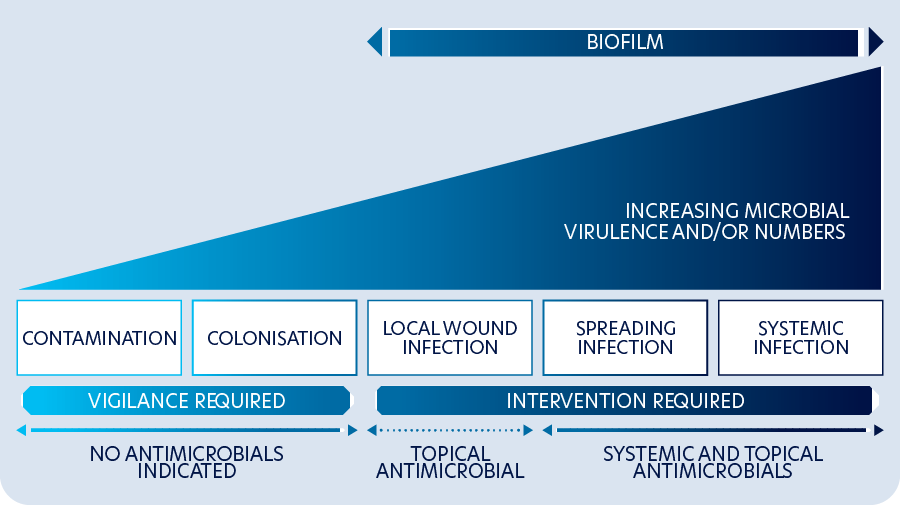Wound Infection
Five Stages of Wound Infection Continuum
| Wound stage | Definition |
|---|---|
| Contamination |
|
| Colonisation |
|
| Local Infection |
|
| Spreading Infection |
|
| Systemic Infection |
|
(Jones, 2012; IWII, 2022)
Infection Continuum International Consensus Update, 2022
Contamination
The presence of non-proliferating microbes within a wound at a level that does not evoke a host response, delay or impede wound healing. Virtually from the time of the wound occurring, all open wounds are contaminated with microbes. Wounds become contaminated from endogenous skin flora and exogenous microbial sources, such as poor general hand hygiene and environmental exposure. Unless compromised, the host defences respond swiftly to destroy the bacteria.
In contaminated wounds, microorganisms are present within the wound but are not proliferating. There is no significant host reaction and no delay in healing (IWII, 2022).
Colonisation
Refers to the presence within the wound of microbial organisms that undergo limited proliferation without evoking a host reaction. Microbial growth occurs at a
non-critical level, and wound healing is not impeded or delayed. Sources for microorganisms may be natural flora, exogenous sources or because of environmental exposure.
In colonised wounds, microorganisms are present within the wound but are not proliferating. There is no significant host reaction and no delay in healing. (IWII, 2022)
Local wound infection
Occurs when bacteria or other microbes move deeper into the wound tissue and proliferate at a rate that invokes a response in the host. Local infection is contained within the wound and the immediate periwound region (less than 2cm). Local infection often presents as covert (subtle) signs and symptoms that may not be immediately recognised as a sign
of infection.
Signs and symptoms:
Covert (subtle)
- Hypergranulation
- Bleeding, friable granulation
- Epithelial bridging and pocketing in granulation tissue
- Increasing exudate
- Delayed wound healing beyond expectations
Overt (classic)
- Erythema
- Local warmth
- Swelling
- Pain
- Purulent discharge
- Wound breakdown and enlargement
- New and increasing pain
- Increasing malodour
(IWII, 2022)
Spreading infection
Describes the invasion of the surrounding tissue by infective organisms that have a spread
of <2 cm from a wound.
The multiplying micro-organisms within the wound overwhelm the individual’s immune response, resulting in associated clinical signs and symptoms. Spreading infection may involve deep tissue, muscle, fascia, organs, or body cavities.
Signs and symptoms:
- Extending induration
- Spreading erythema
- Pain
- Lymphangitis
- Crepitus
- Wound breakdown/dehiscence with or without satellite lesions
- Inflammation, swelling of lymph glands
(IWII, 2022)
Systemic infection
Systemic infection is the stage in which microorganisms have spread throughout the body via the vascular or lymphatic systems, that affects the body as a whole. In the context of wound infection, microorganisms spread from a locally infected wound. Systemic inflammatory response can also be triggered by a local wound infection through other pathways, for example release of toxins or a dysregulated immune system.
Sepsis and organ dysfunction are signs of systemic infection.
Signs and symptoms:
- Malaise
- Lethargy or non-specific general deterioration
- Loss of appetite
- Fever/pyrexia
- Pain
- Severe sepsis
- Septic shock
- Organ failure
- Death
(IWII, 2022)
